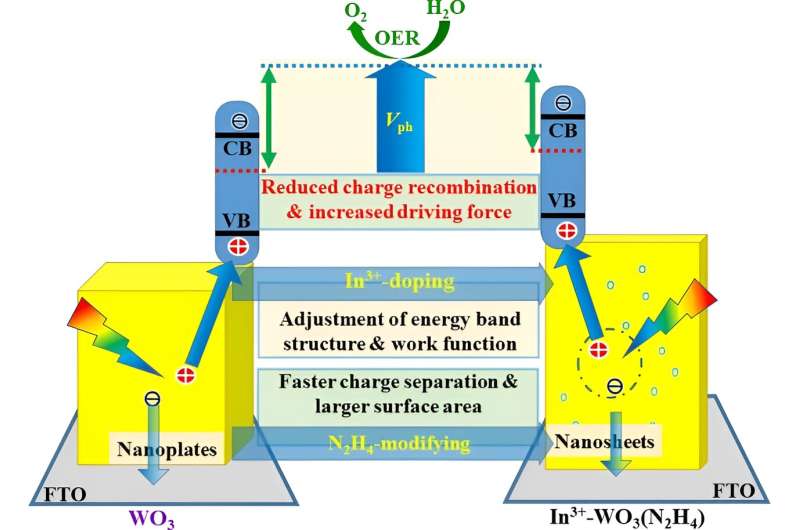This article has been reviewed according to Science X's editorial process and policies. Editors have highlighted the following attributes while ensuring the content's credibility:
fact-checked
trusted source
proofread
Novel nanostructured photoanode hydrothermally prepared at 160°C, followed by 500°C calcination

A new study led by Prof. Tianyou Peng (College of Chemistry and Molecular Sciences, Wuhan University) and Associate Prof. Peng Zeng (School of Food and Pharmaceutical Engineering, Zhaoqing University) describes how a novel nanostructured WO3-based photoanode was hydrothermally prepared at 160°C followed by 500°C calcination.
In addition, the influence mechanism of hydrazine hydrate and In3+-doping on the microstructure, photoelectrochemical behavior, electronic band structure and work function of WO3 photoanode was studied.
The work is published in the journal Science China Chemistry.
The experiment results show that the photocurrent density and stability of the nanostructured WO3 photoanode are closely related to its microstructure, morphology and electronic band structure, whereby the introduction of hydrazine hydrate as texture regulator in the hydrothermal reaction solution leads to the formation layered WO3 film stacked by (020) facet-exposed nanosheets with ~300 nm length (along the [200] direction) and ~150 nm width (along the [002] direction).
This increases the specific surface area and reactive sites to promote the charge transfer and separation; In3+-doping optimizes the electronic band structure of WO3, resulting in negatively shifted flat band potential and reduced work function to enhance the driving force of OER.
Compared to In3+ ions, the introduction of hydrazine hydrate has more significant improvement effects on the photocurrent density, applied bias photon-to-current efficiency (ABPE), incident-photon-to-current conversion efficiency (IPCE), photoelectrochemical durability and Faraday efficiency for O2 evolution.
Under the synergistic effect of hydrazine hydrate modification and In3+-doping, the OER performance of In3+-WO3(N2H4) photoanode was significantly improved.
Under conditions of AM1.5G simulated sunlight illumination, Na2SO4 solution and 1.23 V vs. RHE, the In3+-WO3(N2H4) photoanode constructed under the optimized conditions exhibited an IPCE of 38.6% (at 410 nm) and a photocurrent density of 1.93 mA cm-2, which are 2.8 and 3.0 times that of the pure WO3 photoanode, respectively.
This OER performance of In3+-WO3(N2H4) is comparable to or even better than most reported WO3-based photoanodes, indicating its practical application potential in PEC water splitting. This research provides a promising strategy to improve the PEC OER performance of nanostructured WO3 photoanodes by altering their microstructure and introducing heteroatoms.
More information: Peng Zeng et al, Architecture modification and In3+-doping of WO3 photoanodes to boost the photoelectrochemical water oxidation performance, Science China Chemistry (2023). DOI: 10.1007/s11426-023-1691-1
Provided by Science China Press





















